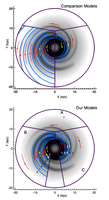Modeling the Magnetic Field in the Galactic Disk using New Rotation Measure Observations from the Very Large Array
Investigators: Cameron Van Eck (1), Jo-Anne Brown (1), Jeroen Stil (1), Kyle Rae (1), Sui Ann Mao (2,3), Bryan Gaensler (4), Anvar Shukurov (5), Russ Taylor (1), Marijke Haverkorn (6,7), Phil Kronberg (8,9), Naomi McClure-Griffiths (3)
(1) Univ Calgary, (2) Harvard-Smithsonian Center for Astrophysics, (3) ATNF, CSIRO Astronomy and Space Science, (4) Sydney Institute for Astronomy, (5) Univ Newcastle, (6) ASTRON, (7) Leiden Univ, (8) Univ Toronto, (9) Los Alamos National Laboratory.
 We have determined 194 Faraday rotation measures (RMs) of polarized extragalactic radio sources using new, multi-channel polarization observations at frequencies around 1.4 GHz from the Very Large Array (VLA) in the Galactic plane at 17o ≤ l≤ 63o and 205o ≤ l ≤ 253o. This catalog fills in gaps in the RM coverage of the Galactic plane between the Canadian Galactic Plane Survey and Southern Galactic Plane Survey. Using this catalog we have tested the validity of recently-proposed axisymmetric and bisymmetric models of the large-scale (or regular) Galactic magnetic field, and found that of the existing models we tested, an axisymmetric spiral model with reversals occurring in rings (as opposed to along spiral arms) best matched our observations. Building on this, we have performed our own modeling, using RMs from both extragalactic sources and pulsars. By developing independent models for the magnetic field in the outer and inner Galaxy, we conclude that in the inner Galaxy, the magnetic field closely follows the spiral arms, while in the outer Galaxy, the field is consistent with being purely azimuthal.Furthermore, the models contain no reversals in the outer Galaxy, and together seem to suggest the existence of a single reversed region that spirals out from the Galactic center.
We have determined 194 Faraday rotation measures (RMs) of polarized extragalactic radio sources using new, multi-channel polarization observations at frequencies around 1.4 GHz from the Very Large Array (VLA) in the Galactic plane at 17o ≤ l≤ 63o and 205o ≤ l ≤ 253o. This catalog fills in gaps in the RM coverage of the Galactic plane between the Canadian Galactic Plane Survey and Southern Galactic Plane Survey. Using this catalog we have tested the validity of recently-proposed axisymmetric and bisymmetric models of the large-scale (or regular) Galactic magnetic field, and found that of the existing models we tested, an axisymmetric spiral model with reversals occurring in rings (as opposed to along spiral arms) best matched our observations. Building on this, we have performed our own modeling, using RMs from both extragalactic sources and pulsars. By developing independent models for the magnetic field in the outer and inner Galaxy, we conclude that in the inner Galaxy, the magnetic field closely follows the spiral arms, while in the outer Galaxy, the field is consistent with being purely azimuthal.Furthermore, the models contain no reversals in the outer Galaxy, and together seem to suggest the existence of a single reversed region that spirals out from the Galactic center.
Publication: Astrophysical Journal, 2011, 728, 97. arXiv: 1012.2938V1 (25 Jan 2011)




Connect with NRAO